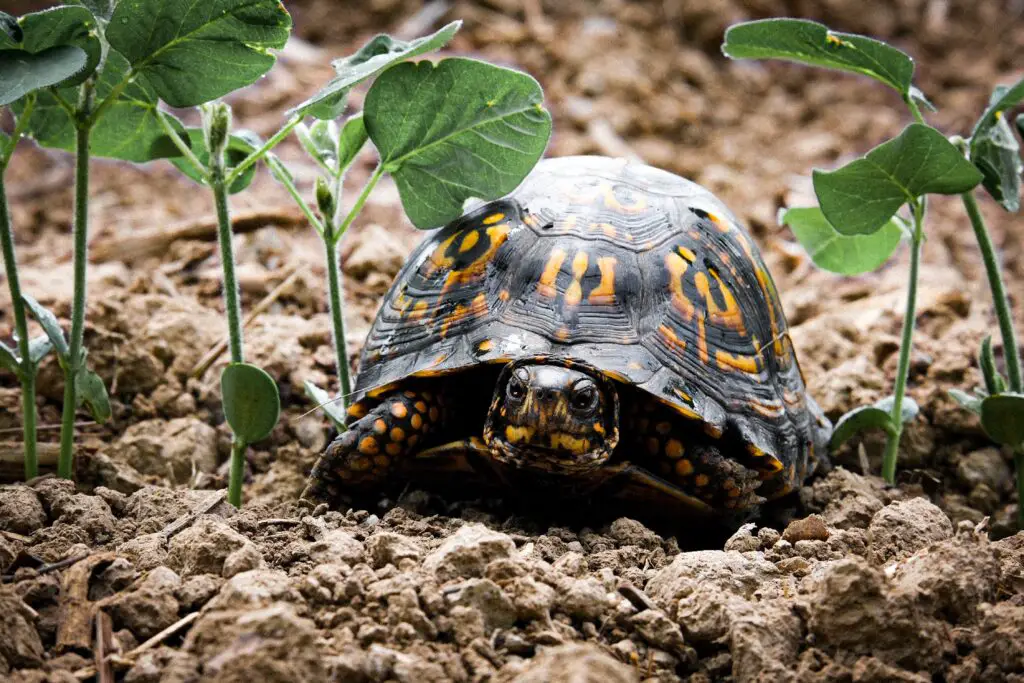What does eastern box turtle eat
What does eastern box turtle eat: The Eastern box turtle (Terrapene carolina) is an enchanting reptile that belongs to the Emydidae family. These marvelous creatures are native to the eastern part of North America, particularly in regions spanning from southern Maine to Florida and westward to parts of Texas, Illinois, and Michigan. Renowned for their dome-shaped carapace and unique yellow and black markings, these turtles are a fascinating sight in the wild.
Brief Overview of the Eastern Box Turtle
The Eastern box turtle is a medium-sized terrestrial turtle that typically measures around 4-7 inches long. Its distinct appearance is characterized by its highly arched upper shell (carapace), which offers excellent protection against predators. The carapace’s coloration varies across individuals, ranging from olive green or brown to reddish-brown or black, often decorated with intricate yellow or orange markings.
The plastron, or lower shell, is hinged and can be completely closed, allowing the turtle to withdraw its head, limbs, and tail within for safety. Furthermore, Eastern box turtles exhibit sexual dimorphism: males have red eyes while females possess yellow-brown eyes.
Additionally, males tend to have more concave plastrons compared to females. These turtles are also known for their impressive lifespan; some individuals have been recorded living up to 100 years in captivity.
Importance of Understanding Its Diet
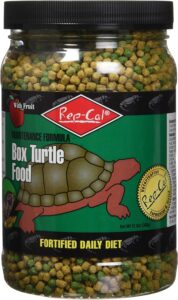 Understanding the diet of the Eastern box turtle is vital for several reasons. Firstly, by comprehending what these turtles consume in their natural habitat, we can better replicate their dietary requirements when caring for them as pets. Providing appropriate nutrition ensures their optimal health and well-being in captivity.
Understanding the diet of the Eastern box turtle is vital for several reasons. Firstly, by comprehending what these turtles consume in their natural habitat, we can better replicate their dietary requirements when caring for them as pets. Providing appropriate nutrition ensures their optimal health and well-being in captivity.
Additionally, comprehending their diet aids conservation efforts by identifying potential threats related to food availability in their native ecosystems. As human activities encroach upon natural habitats, it is crucial to recognize the impacts that habitat loss and changes in food availability may have on Eastern box turtle populations.
By studying their diet, scientists can assess the suitability of various habitats for these remarkable creatures and make informed decisions regarding their conservation. Understanding the Eastern box turtle’s diet provides valuable insights into the ecological role they play within their ecosystems.
As omnivores, these turtles contribute to seed dispersal by consuming fruits and berries. Their consumption of insects and other invertebrates helps control population levels and maintain ecosystem balance.
Therefore, gaining knowledge about their dietary preferences allows us to appreciate the intricate interconnections between species within a given ecosystem. The Eastern box turtle is an intriguing reptile with unique traits and characteristics that distinguish it from other turtles.
Understanding its diet is crucial for proper care in captivity, conservation efforts in natural habitats, and recognizing its ecological significance within ecosystems. In the following sections of this article, we will delve into the specific food sources consumed by Eastern box turtles, exploring both plant-based and animal-based components of their diet as well as specialized dietary preferences they may exhibit.
General Diet of Eastern Box Turtles
Omnivorous Nature
Eastern box turtles (Terrapene carolina) are fascinating creatures known for their omnivorous feeding habits. This means they consume a diverse range of both plant and animal-based food sources.
This adaptability provides them with the ability to thrive in various habitats, including forests, grasslands, and wetlands. Their omnivory allows them to take advantage of available resources, making them versatile foragers.
Variety of Food Sources
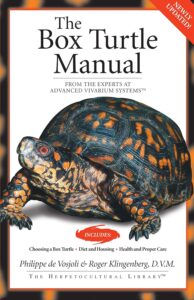 Eastern box turtles have a wide array of food sources to choose from in their environment. They exhibit a preference for certain types of plants, including fruits, berries, and vegetables.
Eastern box turtles have a wide array of food sources to choose from in their environment. They exhibit a preference for certain types of plants, including fruits, berries, and vegetables.
Ripe fruits such as strawberries, blackberries, apples, and melons are particularly appealing to these reptiles due to their sweet taste and high nutritional value. In addition to fruits and berries, eastern box turtles also include vegetables and leafy greens in their diet.
Lettuce, kale, spinach, and carrots are among the vegetables commonly consumed by these turtles. These plant-based foods provide them with a rich source of vitamins and minerals necessary for their overall health.
Moreover, eastern box turtles supplement their diet with animal-based foods such as insects and worms. Insects like earthworms, beetles, caterpillars form an essential part of their diet due to their abundance in the turtle’s natural habitat.
The consumption of these protein-rich prey items ensures proper growth and development. The eastern box turtle also exhibits an interesting specialized dietary preference for uncommon food sources like mushrooms.
While it is not yet fully understood why certain mushroom species attract these turtles’ attention selectively; some individuals have been observed actively seeking out mushrooms like chanterelles or morels as part of their diet. Furthermore, eastern box turtles may opportunistically feed on carrion – dead animals found in their surroundings.
This behavior provides them with an additional protein source and may be particularly beneficial during times when other food sources are scarce. Overall, eastern box turtles have a broad diet that consists of various plant-based and animal-based foods.
Their adaptability to different environments and ability to consume a diverse range of food sources contribute to their survival and success as a species. It is crucial to understand their dietary preferences and requirements to ensure their conservation and well-being in the face of habitat loss and human activities.
Plant-Based Foods
Plants play a significant role in the diet of the eastern box turtle, contributing to their overall health and nutritional requirements. Despite being omnivorous, these charming reptiles have a particular fondness for plant-based foods. Consuming fruits, berries, vegetables, and leafy greens provides them with essential vitamins, minerals, and fiber necessary for growth and maintenance.
Fruits and Berries
Eastern box turtles demonstrate a preference for ripe fruits due to their heightened sweetness and softer texture. They are particularly drawn to succulent treats such as strawberries, blackberries, apples, and melons. These delectable goodies not only satisfy their taste buds but also provide vital nutrients like Vitamin C. While indulging in these juicy delights may bring joy to these marvelous creatures, it is crucial for owners or caretakers to ensure that the fruits are ripe but not overly spoiled or fermented.
Vegetables and Leafy Greens
What does eastern box turtle eat: In addition to fruits and berries, eastern box turtles greatly benefit from incorporating an assortment of vegetables and leafy greens into their diet. These plant-based options offer a plethora of vitamins (such as A, K) as well as minerals (such as calcium) that contribute to the turtle’s overall well-being.
Staples like lettuce – both romaine and green leaf – provide a refreshing crunch along with valuable nutrients. Nutrient-dense veggies like kale, spinach, and carrots are also highly favored by eastern box turtles due to their vibrant colors and exceptional taste.
Including an array of plant-based foods ensures that eastern box turtles receive a balanced diet while enjoying a diverse range of flavors. The combination of succulent fruits with nutrient-rich vegetables promotes healthy digestion processes while providing essential vitamins like C and K. By including strawberries, blackberries, apples, melons alongside lettuces such as romaine or green leaf varieties along with nutritious kale, spinach, or carrots, caretakers can create a wholesome meal plan that nurtures the eastern box turtle’s overall health.
Animal-Based Foods
Insects and Worms
Eastern box turtles have a strong inclination towards animal-based foods, with insects and worms being a significant part of their diet. In their natural habitat, these small creatures are abundant, providing an easily accessible food source for the turtles.
They rely on this protein-rich prey to fulfill their dietary requirements and maintain optimal health. Among the preferred prey items for eastern box turtles are earthworms, beetles, and caterpillars.
These critters are not only plentiful but also offer a diverse array of nutritional benefits. Earthworms serve as an excellent source of protein and essential amino acids.
Beetles provide additional protein content as well as various vitamins and minerals. Caterpillars, on the other hand, contain high levels of essential fatty acids that contribute to the turtle’s overall well-being.
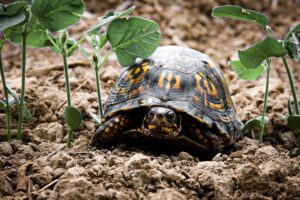
Slugs and Snails
What does eastern box turtle eat: Not only are eastern box turtles fond of insects and worms, but they also exhibit a particular affinity towards slugs and snails. These slimy gastropods play an important role in the turtle’s diet due to their calcium-rich shells.
Calcium is crucial for shell growth in young turtles as well as maintaining shell strength in adults. Garden snails and slugs are commonly found in the eastern box turtle’s habitat, making them easily accessible sources of nutrition.
The consumption of these calcium-rich creatures helps ensure proper bone development and prevents deformities or weaknesses in the turtle’s protective shell. Animal-based foods form a vital component of the eastern box turtle’s diet.
Insects such as earthworms, beetles, and caterpillars offer protein-packed meals with additional nutrients necessary for overall health. Slugs and snails provide not just a source of sustenance but also contribute significantly to shell strength through their calcium-rich shells.
Specialized Dietary Preferences
Mushrooms: Unlocking the Secret of Exquisite Palates
With their intriguing ecological niche, Eastern box turtles often surprise us with their refined and diverse tastes. While commonly known to feast on a variety of plant-based and animal-based foods, their preference for certain mushroom species remains a hidden gem within their culinary repertoire. Native to woodlands and forests, these delightful reptiles have been found to relish the earthy delights of mushrooms, particularly the exquisite chanterelles and morels.
Chanterelles, with their vibrant golden hue and delicate trumpet shape, are highly prized by gourmands across the globe. Remarkably, Eastern box turtles share this discerning taste as they saunter through the forest floor in search of these prized fungi.
The fruity aroma emitted by chanterelles seems to captivate these turtles’ olfactory senses, leading them on an epicurean adventure like no other. Similarly, morel mushrooms also hold a special place in their hearts—or rather taste buds—with its distinct honeycomb-like cap inviting exploration for both visual appeal and gastronomic pleasure.
Carrion: A Scavenger’s Feast for the Discerning Palate
In nature’s grand tapestry of life and death, even carrion has its role to play in sustaining Eastern box turtles’ dietary preferences. These resourceful reptiles have developed opportunistic feeding habits that extend beyond conventional omnivory.
When encountering deceased animals during their wanderings through meadows or woodlands, they seize the opportunity without hesitation—indulging in this unexpected source of sustenance that provides an additional protein boost to their diet. Carrion consumption not only satisfies the need for proteins but also showcases these turtles’ adaptive behavior when faced with available resources.
They skillfully scavenge carcasses left behind by nature’s cycle—be it a small mammal or bird—to ensure their nutritional needs are met. This remarkable ability to exploit unconventional food sources further highlights the versatility of Eastern box turtles as keen survivors in their ever-changing ecosystems.
A Taste for the Extraordinary: Unveiling Unconventional Tastes
What does eastern box turtle eat: The eastern box turtle’s specialized dietary preferences, including their fondness for certain mushrooms and carrion, provide a captivating glimpse into the depth of their palate. These reptiles have evolved to appreciate nature’s gastronomic wonders beyond a standard omnivorous diet.
The allure of chanterelles and morels, resonating with their refined senses, adds an air of sophistication to their feeding habits. Similarly, indulging in carrion demonstrates their adaptability and resourcefulness when faced with unexpected protein-rich opportunities.
As we delve deeper into the world of Eastern box turtles’ dietary choices, it becomes evident that these marvelous creatures possess an innate appreciation for nature’s culinary offerings. Their selective tastes offer us a poignant reminder that even within the hidden corners of the animal kingdom lies a profound appreciation for extraordinary flavors and unexpected delicacies.
Nutritional Considerations
Proper nutrition is essential for the health and well-being of the eastern box turtle. Two key nutritional considerations for these captivating creatures are their calcium requirements for shell health and their need for vitamin D synthesis through sunlight exposure.
Calcium Requirements for Shell Health
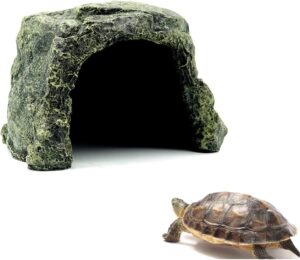 The eastern box turtle’s shell, composed of a bony structure called the carapace, is vital for protection and support. To maintain a healthy and strong shell, adequate calcium intake is crucial. Calcium plays a pivotal role in promoting proper bone growth, preventing deformities, and ensuring overall structural integrity.
The eastern box turtle’s shell, composed of a bony structure called the carapace, is vital for protection and support. To maintain a healthy and strong shell, adequate calcium intake is crucial. Calcium plays a pivotal role in promoting proper bone growth, preventing deformities, and ensuring overall structural integrity.
In their natural habitat, eastern box turtles obtain calcium from various sources, including animal-based foods like snail shells. Additionally, they rely on plant-based foods such as leafy greens that provide both dietary calcium and naturally occurring oxalic acid levels that do not hinder calcium absorption.
It is important to ensure captive eastern box turtles have access to a well-balanced diet that includes sufficient calcium-rich foods or supplements to meet their daily requirements. Failure to maintain appropriate levels of dietary calcium can lead to metabolic bone disease and other serious health issues.
Vitamin D Synthesis from Sunlight Exposure
Vitamin D plays a critical role in enabling proper absorption of dietary calcium within the box turtle’s body. As ectothermic animals, they rely on external sources of heat, including sunlight exposure, to regulate their body temperature effectively.
Sunlight exposure also triggers the synthesis of vitamin D within their skin. When exposed to ultraviolet B (UVB) rays present in sunlight, a chemical reaction occurs in the skin, converting a precursor molecule into active vitamin D3.
This biologically active form of vitamin D promotes calcium absorption from the intestines, ensuring that the turtle can utilize the calcium obtained from its diet effectively. Inadequate exposure to sunlight or a lack of access to UVB lighting in captive environments can lead to vitamin D deficiency.
Insufficient levels of vitamin D impair calcium absorption and metabolism, potentially resulting in weakened bones and shell deformities. Therefore, providing an appropriate environment with access to natural sunlight or UVB lighting is crucial for maintaining a healthy eastern box turtle’s overall well-being.
Feeding Habits and Foraging Techniques: What does eastern box turtle eat
Diurnal Feeding Patterns
Eastern box turtles are diurnal creatures, which means they are most active during the daylight hours. This is particularly important when considering their feeding habits. These turtles are known to start foraging for food shortly after sunrise and continue until late afternoon.
Their active daytime feeding behavior allows them to take advantage of the optimal light and temperature conditions that facilitate their search for nourishment. When the sun begins to rise, eastern box turtles emerge from their hiding spots, often found under leaf litter or in shady areas.
They embark on a daily journey in search of sustenance, utilizing their keen sense of smell and sight to locate potential food sources. Their diurnal feeding patterns ensure they have ample time during daylight hours to secure the necessary nutrients needed for survival.
Burrowing Behavior to Find Food
To find food, eastern box turtles employ a fascinating burrowing behavior that sets them apart from many other turtle species. Due to their relatively small size and limited mobility compared to larger predators, these turtles rely on digging into soft soil or leaf litter using their sturdy forelimbs. Their burrowing behavior serves two important purposes: locating hidden prey items and accessing underground plant roots.
By excavating shallow depressions in the ground or carefully digging through loose soil layers, eastern box turtles reveal insects, worms, grubs, and other small organisms that dwell beneath the surface. Furthermore, this burrowing behavior also enables them to reach tender roots of plants growing belowground.
Eastern box turtles have been observed scraping away at soil layers near shrubs or trees with edible roots such as dandelion greens or tubers like wild potatoes. This specialized foraging technique allows them access to a diverse range of food options throughout their natural habitat.
Eastern box turtles exhibit diurnal feeding patterns that align with their active daytime behavior. They rely on their exceptional senses to locate food sources and make the most of the favorable daylight conditions.
Additionally, their burrowing behavior plays a crucial role in uncovering both animal-based prey and plant-based sustenance. This unique foraging technique showcases the adaptable nature of these turtles as they utilize their physical abilities to secure a varied and nutritious diet.
Conservation Concerns
Habitat Loss Affecting Food Availability
What does eastern box turtle eat: One of the critical conservation concerns regarding the eastern box turtle is the loss and degradation of its natural habitat. As human populations continue to expand, urbanization and infrastructure development encroach upon the turtle’s native habitats, resulting in fragmented ecosystems and limited foraging opportunities.
The destruction of forests, wetlands, and meadows not only reduces the available food sources for box turtles but also disrupts their ability to move freely between different feeding areas. This loss of suitable habitat puts significant strain on their ability to find an adequate food supply.
Moreover, deforestation and land conversion lead to a decline in plant diversity, affecting both plant-based foods and the insects that rely on these plants. Eastern box turtles depend on a varied diet comprising fruits, vegetables, insects, worms, and other small prey items found in their natural habitats.
Reductions in plant diversity can lead to decreased availability of essential nutrients necessary for their survival. Additionally, decreased insect populations due to habitat loss further limit the turtles’ access to protein-rich food sources.
Impact of Human Activities
The impact of human activities extends beyond habitat loss and directly affects eastern box turtle populations through several detrimental practices. One significant impact is road mortality caused by vehicle collisions. Box turtles are relatively slow-moving creatures with a tendency to cross roads throughout their range.
Unfortunately, increased road networks fragment their habitats further and expose them to higher risks of being struck by vehicles during these crossings. Additionally, urbanization introduces various pollutants into the environment that can directly or indirectly affect eastern box turtles’ health and food sources.
Pesticides used in agricultural practices can contaminate water bodies or be ingested by prey items consumed by box turtles. These pesticides may disrupt their delicate digestive systems or accumulate within their bodies over time, leading to long-term negative effects.
To sum up what does eastern box turtle eat
While the eastern box turtle faces numerous challenges due to habitat loss and the impact of human activities, there is still hope for their conservation. Conservation efforts aimed at preserving and restoring their natural habitats play a vital role in ensuring their survival. By protecting and connecting fragmented ecosystems, we can provide the turtles with access to a diverse range of food sources.
Furthermore, raising awareness about these remarkable creatures and promoting responsible practices, such as reducing pesticide use and taking precautions to avoid road collisions, can significantly mitigate the threats they face. Ultimately, by valuing and respecting the natural world around us, we can create a harmonious coexistence with species like the eastern box turtle, ensuring their continued presence in our ecosystems for generations to come.
Further Reading
How To Keep My Turtle Tank From Smelling
How To Decorate a Turtle Tank: DIY Guide

